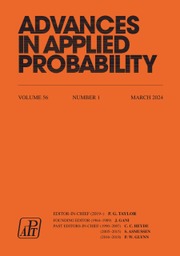No CrossRef data available.
Article contents
Extremal behavior of stationary marked point processes
Published online by Cambridge University Press: 18 June 2025
Abstract
We consider stationary configurations of points in Euclidean space that are marked by positive random variables called scores. The scores are allowed to depend on the relative positions of other points and outside sources of randomness. Such models have been thoroughly studied in stochastic geometry, e.g. in the context of random tessellations or random geometric graphs. It turns out that in a neighborhood of a point with an extreme score it is possible to rescale positions and scores of nearby points to obtain a limiting point process, which we call the tail configuration. Under some assumptions on dependence between scores, this local limit determines the global asymptotics for extreme scores within increasing windows in  $\mathbb{R}^d$. The main result establishes the convergence of rescaled positions and clusters of high scores to a Poisson cluster process, quantifying the idea of the Poisson clumping heuristic by Aldous (1989, in the point process setting). In contrast to the existing results, our framework allows for explicit calculation of essentially all extremal quantities related to the limiting behavior of extremes. We apply our results to models based on (marked) Poisson processes where the scores depend on the distance to the kth nearest neighbor and where scores are allowed to propagate through a random network of points depending on their locations.
$\mathbb{R}^d$. The main result establishes the convergence of rescaled positions and clusters of high scores to a Poisson cluster process, quantifying the idea of the Poisson clumping heuristic by Aldous (1989, in the point process setting). In contrast to the existing results, our framework allows for explicit calculation of essentially all extremal quantities related to the limiting behavior of extremes. We apply our results to models based on (marked) Poisson processes where the scores depend on the distance to the kth nearest neighbor and where scores are allowed to propagate through a random network of points depending on their locations.
MSC classification
Information
- Type
- Original Article
- Information
- Copyright
- © The Author(s), 2025. Published by Cambridge University Press on behalf of Applied Probability Trust


